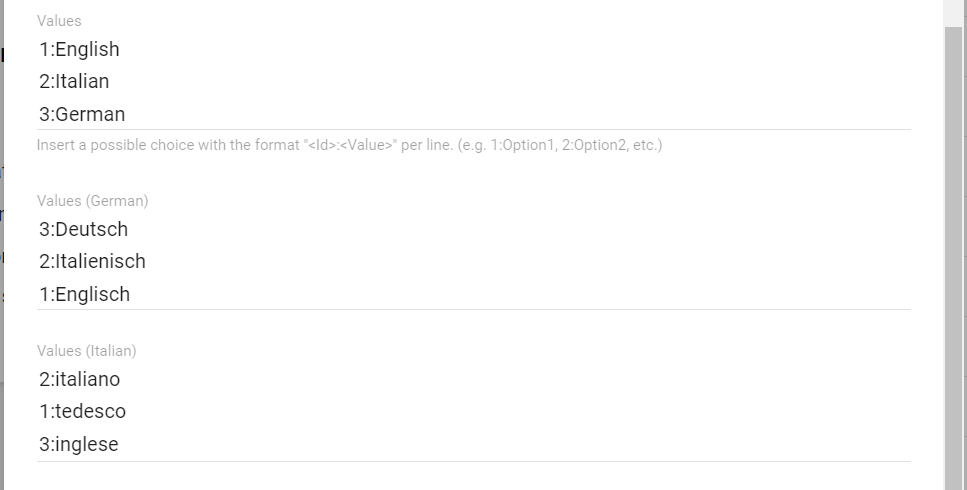Adding dropdown fields to your job opening or employee file is very practical. This guide explains the simple procedure.
Creation in the recruiting module
Here’s how it works:
- In the side menu on the left, click on ‘Settings’ –> ‘Recruiting’ –> ‘General’
- Click on the ‘Application form’ tab
- The fields of your application form and the internal fields appear here in list form
- Click on the ‘+’ button
- The pop-up ‘Add entry’ opens
- Under ‘Type’, select the option ‘Dropdown’ or ‘Dropdown (multi-select)’
- Name the field (e.g. ‘Languages’)
- Enter values for the selection options (explanation, see below)
- Click on ‘Save’
Creation in the recruiting module Talent Management Modul
Here’s how it works:
- In the side menu on the left under ‘Settings’, click on ‘Talent Management’ –> ‘Fields’
- Here you can select the category of the details in which you want to create the fields in the filter on the left. You can also create a new category or change the name
- Click on the ‘+’ button
- The ‘Add entry’ pop-up opens
- Under ‘Type’, select the option ‘Dropdown’ or ‘Dropdown (multi-select)’
- Name the field (e.g. ‘Languages’)
- Enter values for the selection options (explanation, see below)
- Click on ‘Save’
What does ‘values’ mean?
Selection options in dropdowns are specified in the format <id>:<value>
The value bears the name of the selection option and is assigned to an ID. The simplest solution for IDs is numbering, e.g. 1:option1, 2:option2; but of course you can also assign exact IDs, e.g. de:German, en:English.
Examples of dropdowns
Enter in the field:

According to this principle, you can also adopt the order of the selection options in the view of other languages. If an applicant is now viewing the form in German, ‘German’ will be at the top of the language dropdown, whereas an applicant in Italian will see ‘italiano’ at the top.
Frequently used examples:
en:ingelese
it:italiano
de:tedesco
Italian
it:italiano
de:tedesco
en:ingelese
German
de:german
it:italian
en:english
5:First language (C2)
4:Excellent (C1)
3:Very good (B2)
2:Good (B1)
1:Basic (A2/A1)
0:none
German
5:Muttersprache (C2)
4:fließend (C1)
3:sehr gut (B2)
2:gut (B1)
1:Grundkenntnisse (A2/A1)
0:keine
Italian
5:Madrelingua (C2)
4:Ottimo (C1)
3:Molto buono (B2)
2:Buono (B1)
1:Conoscenze base (A2/A1)
0:nessuna conoscenza
1:Our website
2:Recommendation/Reference
3:Print media
4:Job exchange
5:LinkedIn
6:Facebook
7:Other social media
8:Other
Italian
1:Il nostro sito web
2:Raccomandazione/Riferimento
3:Giornale
4:Borsa del lavoro
5:LinkedIn
6:Facebook
7:Altri social media
8:Altro
German
1:Unsere Webseite
2:Empfehlung/Referenz
3:Print-Medien
4:Jobbörse
5:LinkedIn
6:Facebook
7:Andere Social Media
8:Sonstige
1:none
2:about to do (B)
3:B (car)
4:C (small lorry)
5:C (small lorry) + FQN (driver qualification certificate)
6:D (lorry)
7:D (lorry) + FQN (driver qualification certificate)
8:BC
9:E (bus)
10:E (bus) + FQN
German
1:keiner
2:dabei zu machen (B)
3:B (Auto)
4:C (Kleinlastwagen)
5:C (Kleinlastwagen) + FQN (Fahrerqualifiz. Nachweis)
6:D (Lkw)
7:D (Lkw) + FQN (Fahrerqualifiz. Nachweis)
8:BC
9:E (Autobus)
10:E (Autobus) + FQN
Italian
1:nessuno
2:in corso (B)
3:B
4:C
5:C + CQC
6:D
7:D + CQC
8:BC
9:E
10:E + CQC
1:single
2:married
3:widowed
4:legally separated
5:divorced
6:deceased
7:guardian
8:minor children
9:abandoned
10:registered civil partnership
11:registered civil partnership cancelled
12:registered civil partner deceased
Italian
1:celibe/nubile
2:coniugato/a
3:vedovo/a
4:separato/a legalmente
5:divorziato/a
6:deceduto/a
7:tutelato/a
8:figlio/a minore
9:abbandonato/a
10:unito/a civilmente
11:sciolto/a da unione civile
12:parte superstite unione civile
German
1:ledig
2:verheiratet
3:verwitwet
4:gesetzlich getrennt
5:geschieden
6:verstorben
7:Vormund
8:minderjährige Kinder
9:verlassen
10:eingetragene Lebenspartnerschaft
11:eingetragene Lebenspartnerschaft aufgehoben
12:eingetragene Lebenspartnerin/eingetragener Lebenspartner verstorben
1:Middle school
2:Secondary school
3:Vocational school
4:University (Bachelor)
5:University (Master)
German
1:Mittelschule
2:Oberschule
3:Berufschule
4:Universität (Bachelor)
5:Universität (Master)
Italian
1:Scuola media
2:Scuola secondaria
3:Scuola professionale
4:Università (Bachelor)
5:Università (Master)
